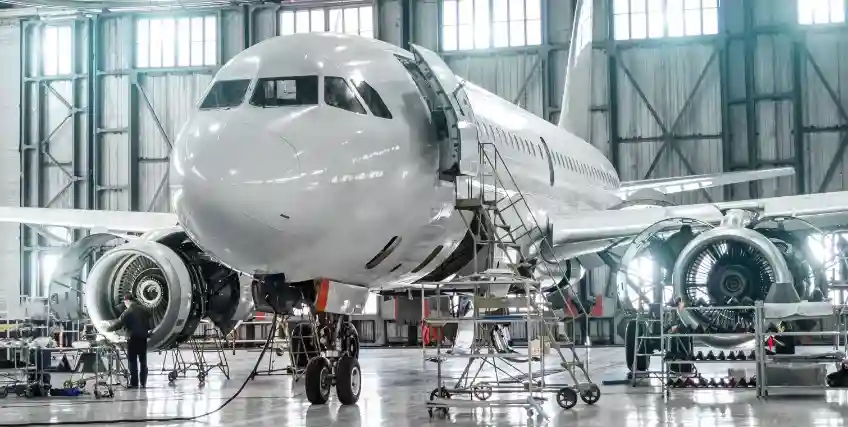Aviation Financing Explained: What You Need to Know
July 08, 2025 | Last Updated on: July 14, 2025

Companies in the aviation sector have significant expenses. Whether you operate a charter service, an MRO (Maintenance, Repair, and Overhaul) facility, an FBO (Fixed-Base Operator), or an aerospace manufacturing enterprise, access to capital is crucial to help the company expand, innovate, and capitalize on new opportunities. Aviation loans can be a major contributor to your company’s success.
Here, we break down aviation financing to help you navigate this specialized landscape.
In this article:
- Learn the types of aviation loans available, from traditional asset-based aircraft financing to special options from aircraft financing companies.
- Understand the critical factors lenders consider.
- Discover what you need to secure financing from the best aircraft finance companies.
The Specialized Nature of Aviation Financing
Before delving into the specifics of various aviation loans, you have to understand why this sector is so different from traditional business financing. Whether you have a fleet of private aircraft or are just a solo private pilot, the high value of the assets involved in the business and extended operational lifespans influence collateral requirements and loan terms. Moreover, the aviation industry has many regulatory requirements for safety and operational standards that impact how lenders value assets and assess aviation loan risk.
Plus, you may also be subject to international legal frameworks and international transactions. All in all, it’s a complex financing ecosystem that requires expertise from both borrowers and lenders.
Types of Aviation Loans Available
There are several types of aviation loans to address a range of financing needs. Each may have advantages and disadvantages, and the right choice will depend on your specific needs, financial health, and strategic objectives.
Term Loans
For many established aviation businesses, traditional aviation loans from commercial banks and specialized aviation finance companies remain a cornerstone of their funding strategy. Term loans provide a lump sum of capital upfront that you repay with monthly payments based on an interest rate. These loans are well-suited for specific, large-scale investments like purchasing a new aircraft or funding the expansion into a new hangar.
Loans may be secured or unsecured, meaning they may require collateral or not. Usually, aviation loans are secured by aircraft since they are such high-value business assets. Hangars or MRO equipment may also serve as collateral to reduce loan rates and mitigate risk for the lender. Smaller aviation loans, for things like working capital upgrades or investment in flight school and flight training for new employees, may not require collateral.
Business Lines of Credit
Revolving lines of credit offer substantial flexibility, allowing you to draw funds when you need them and pay them back to retain access to the full credit limit. Lines of credit offer a useful way to manage fluctuating operating costs, unexpected maintenance, and bridge temporary cash flow gaps. These aviation loans provide a critical safety net for day-to-day operations.
Asset-Based Lending (ABL)
Asset-based aircraft financing involves securing a financing solution through your company’s assets beyond aircraft. This may be your accounts receivable, inventory, or other operational equipment. If your business has significant assets but is struggling with consistent cash flow or lacks the credit history necessary to qualify for a traditional loan, the best aircraft finance companies may offer unique asset-based lending programs that can be tailored to your specific needs.
Equipment Financing and Leasing
Aviation loans can facilitate direct ownership of aircraft, but leasing remains a highly popular option within the aviation industry.
With an operating lease, you effectively rent the aircraft for a specified duration. You do not hold ownership of the asset, but you retain the right to use it. This can be beneficial for maintaining the flexibility to upgrade to newer models and mitigate the depreciation risk of ownership. At the end of the lease term, you can return the aircraft, extend the lease, or, in some instances, purchase it.
If you want to purchase aircraft outright, equipment loans are specially designed to use the asset itself to secure the loan. Aircraft loans can allow you to pay a fixed rate based on the purchase price and interest rate for a period of time, allowing you to buy the aircraft through a payment plan.
SBA Loans
Smaller aviation businesses can take advantage of loan programs offered by the U.S. Small Business Administration (SBA). Certain SBA loan programs can help you finance aircraft purchases, real estate acquisition, or unlock working capital. SBA loans typically feature lower down payments, longer repayment terms, and more competitive rates than traditional bank aviation loans. However, the eligibility requirements may be strict.
Vendor and Manufacturer Financing
Aircraft manufacturers like Boeing or Airbus and major aviation equipment suppliers occasionally offer their own financing programs to facilitate sales. These programs may include attractive terms, deferred payments, or specialized structures that might not be readily available from third-party lenders. If you are acquiring a new aircraft directly from the manufacturer, it is always advisable to inquire about their financing options.
How to Qualify for Aviation Loans
When you’re ready to explore aviation loans, a lender will conduct a thorough assessment of your business to evaluate the risk of lending to you. Different lenders have varying criteria and eligibility requirements, but generally, this is what they’ll look at and how you can maximize your chances of approval.
- Creditworthiness: Your personal and business credit history is paramount. Lenders will examine your repayment track record, any previous defaults, and your overall financial stability. The stronger your credit score, the better your chances of approval. If you can pay down some outstanding debts before applying, it could help.
- Financial health: You’ll have to show a comprehensive record of financial statements, including profit and loss statements, balance sheets, tax returns, and cash flow projections, typically for the past 2-3 years. Lenders want to see that you have consistent revenue as proof that you can repay the debt. Staying organized and keeping meticulous records is always important.
- Business plan: A well-articulated, realistic business plan could make the difference between approval and denial. Your business plan should outline your strategic objectives, market analysis, operational structure, management team, and how you’ll use the aviation loan to contribute to your growth and profitability.
- Aircraft/Asset specifics: For aircraft loans, you’ll need to submit detailed information concerning the aircraft. This includes its make, model, year of manufacture, current condition, comprehensive maintenance records, and intended use. Lenders often require an independent appraisal of the aircraft.
- Experience and management team: Lenders consistently prefer to collaborate with experienced business owners and management teams with a proven track record within the aviation industry. Establishing relationships with lenders is a good way to streamline the application process and improve your chances of approval for aviation loan.
- Collateral: Aviation loans are typically secured. A higher loan-to-value (LTV) ratio for your collateral generally indicates higher risk for the lender and may result in higher interest rates or less favorable loan terms. You may be able to offset some of these concerns with a bigger down payment.
How to Apply for Aviation Loans
The application process for aviation loans is similar in some ways to traditional financing applications, but different in a few key ways, too. Here’s a general roadmap of what to expect.
- Determine your funding needs: Before you approach lenders, take a close look at your financial situation, growth goals, and determine what kind of capital investment you will need to get there. This process will inform how much funding you apply for and the types of loans you pursue.
- Research and compare lenders: It’s a good idea to find specialized aviation lenders, commercial banks with dedicated aviation departments, and other financial institutions that offer aviation loans. Compare their reputations, eligibility requirements, and loan programs to figure out what might make the most sense for your business.
- Gather documentation and apply: Once you’ve found a preferred lender, you will submit a formal application along with all requested documentation, including financial statements, tax returns, business plans, and detailed aircraft information.
- Underwriting and due diligence: During the underwriting period, the lender will review your application and conduct due diligence about your business and, if you're applying for equipment financing, the piece of equipment you want to acquire.
- Loan offer and negotiation: If approved, the lender gives you a formal loan offer with the terms, interest rate, repayment schedule, and collateral requirements. This is your opportunity to review the offer and negotiate terms if necessary.
- Closing: When you agree to terms, legal documents are prepared and executed, and funds are disbursed.
Conclusion
Aviation financing can seem complex, but when you understand your available options and what lenders are looking for in an application, it can help improve your chances of qualifying for aviation loans. Whether you’re working with traditional banks or aircraft financing companies, there are many options available to help fuel your company’s growth.
FAQs About Aviation Loans
What is the typical down payment required for an aircraft loan?
Generally, an aircraft loan down payment is between 10% and 25% of the aircraft's value. However, it can range depending on the lender, the type and age of the aircraft, your creditworthiness, and the overall loan amount. Generally, you should anticipate needing anywhere from 10% to 25% of the aircraft's value. Certain specialized aviation loans or government-backed programs may offer lower down payment options.
How long does it take to get approval for aviation loans?
The aviation loan approval timeline could be a few business days, or it could be as long as a few months. It depends on the lender’s internal processing times, the intricacy of the deal, and the necessity for appraisals or additional due diligence. Having all required documentation readily available and being highly responsive to lender inquiries can expedite the process.
Can I get aviation loans for a used aircraft?
Many reputable lenders offer aviation loans for both new and pre-owned aircraft. The terms and conditions for a used aircraft loan may differ, but such loans are certainly available.
What types of collateral are typically used for aviation loans?
Usually, the collateral for aviation loans is the aircraft itself. Lenders will place a lien on the aircraft until the loan obligation is fully satisfied. In some specific instances, particularly for asset-based lending, other business assets such as accounts receivable, inventory, or even real estate like hangars or administrative buildings can be used as supplementary collateral.
Are there specific aviation loans for starting a new aviation business?
Startups can get aviation loans, but it’s not easy. Lenders will emphasize the robustness of your business plan, the proven experience of your management team, and your personal financial strength. Government-backed programs such as SBA loans might offer greater accessibility for startups compared to traditional bank loans. You may also be required to provide a higher down payment or more substantial collateral.




